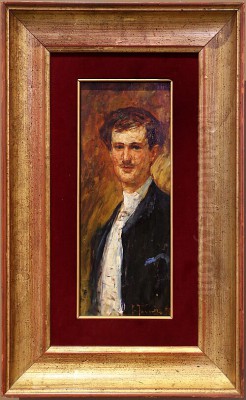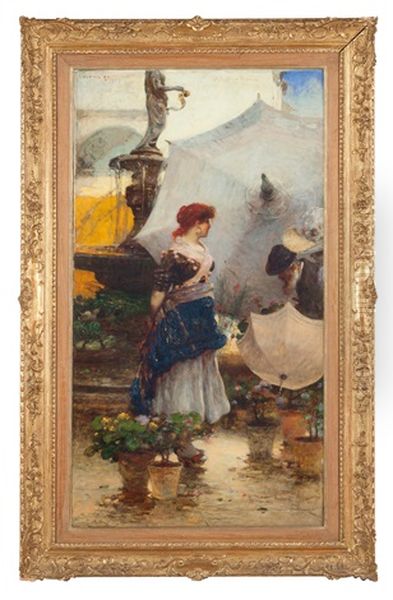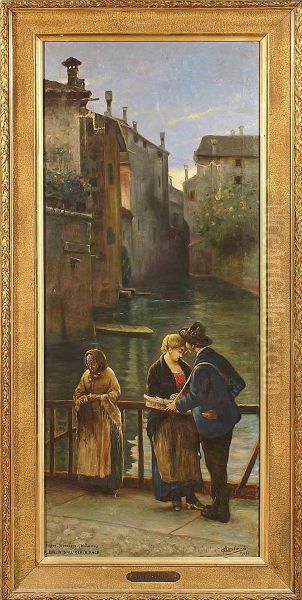
Angelo Dall'Oca Bianca stands as a significant figure in Italian art, a painter whose life and work bridged the late 19th and early 20th centuries. Born in Verona on March 31, 1858, and passing away in his beloved hometown on May 18, 1942, Dall'Oca Bianca carved a unique niche for himself, primarily celebrated for his evocative depictions of Veronese life, landscapes, and his sensitive portraiture. His artistic journey, marked by initial hardship and a persistent dedication to his craft, saw him evolve from a self-taught enthusiast to a respected artist who, while embracing contemporary currents, remained deeply rooted in the traditions and atmosphere of his native region.
Early Life and Artistic Awakening in Verona
Angelo Dall'Oca Bianca's entry into the world of art was not paved with privilege. Born into a family facing economic difficulties, his early passion for drawing and painting was nurtured through sheer determination and self-study. This innate talent, however, soon found a more formal path. He enrolled at the Accademia Cignaroli in Verona, a venerable institution that had been a crucible for artistic talent in the city for generations.
At the Accademia Cignaroli, Dall'Oca Bianca came under the tutelage of Napoleone Nani (1841-1899), a prominent painter and a pivotal figure in Veronese art education at the time. Nani, known for his genre scenes and portraits, was instrumental in shaping a generation of artists. Under Nani's guidance, Dall'Oca Bianca honed his technical skills and began to develop his artistic voice. It was during this period that he formed connections with fellow students who would also go on to achieve recognition, such as Alessandro Milesi (1856-1945) and Giacomo Favretto (1849-1887), both of whom became significant figures in Venetian painting. The shared experiences and artistic dialogues within the academy environment undoubtedly played a role in his formative development.

His pursuit of artistic excellence did not stop in Verona. Dall'Oca Bianca furthered his studies at the Accademia di Belle Arti in Venice. This move was crucial, as Venice, with its rich artistic heritage and vibrant contemporary scene, offered a broader perspective. The city's unique interplay of light and water, its bustling daily life, and the legacy of Venetian masters of color, from Titian to Tiepolo, provided an immersive and inspiring environment.
The Venetian Influence and Emergence
The time spent in Venice was profoundly influential. The city was a hub for artists exploring new modes of expression, moving away from strict academicism towards a more direct engagement with reality and the fleeting effects of light and atmosphere. Here, Dall'Oca Bianca was exposed to the work and ideas of artists like Guglielmo Ciardi (1842-1917) and Luigi Nono (1850-1918). Ciardi was renowned for his luminous Venetian lagoonscapes, capturing the subtle nuances of light with a fresh, almost Impressionistic sensibility. Nono, though often tackling more somber social themes, also demonstrated a keen observational skill and a powerful use of chiaroscuro.
The influence of these artists, along with contemporaries like Ettore Tito (1859-1941), another prominent Venetian painter known for his lively genre scenes and portraits, helped Dall'Oca Bianca refine his approach. He became particularly adept at landscape painting and genre scenes, infusing them with a vibrant palette and a keen eye for detail that captured the essence of everyday life. His ability to render the interplay of light and shadow, and to create harmonious color compositions, became hallmarks of his style.
His burgeoning talent began to gain wider recognition. He participated in significant national exhibitions, such as the Milan National Exhibition in 1881. These platforms allowed him to showcase his work to a broader audience and establish his reputation beyond his local region. An important early success came with his painting Ave Maria, which was exhibited at the Brera in Milan in 1886 and received considerable acclaim, marking a significant milestone in his career.
Capturing Verona's Soul: Style and Thematic Concerns
While his training took him to Venice and his reputation grew nationally, Verona remained the heart of Angelo Dall'Oca Bianca's artistic universe. He returned to his native city, and its landscapes, its people, and its unique urban fabric became his principal subjects. His style can be broadly characterized as a form of Italian Realism, often infused with the vibrancy and light-filled palette reminiscent of Impressionistic tendencies, though he never fully subscribed to the French movement's theoretical underpinnings.

Dall'Oca Bianca excelled in depicting the bustling life of Verona's squares, the quiet charm of its streets, and the natural beauty of its surrounding countryside. He had a particular fondness for Piazza delle Erbe, Verona's historic market square, which he painted numerous times, capturing its lively atmosphere, colorful stalls, and the interplay of light on its ancient buildings. These works are testaments to his skill in composing complex scenes and his ability to convey the spirit of a place.
His genre paintings often focused on the daily lives of ordinary Veronese people, from market vendors to families, rendered with empathy and a keen observational eye. He avoided overt sentimentality, instead striving for an honest portrayal of their joys, sorrows, and everyday routines. His portraits, too, were noted for their psychological insight and their ability to capture the sitter's character.
A period spent in Rome further broadened his artistic horizons. During his time in the capital, Dall'Oca Bianca developed a keen interest in Byzantine art. The rich colors, gold backgrounds, and stylized forms of Byzantine mosaics and icons seem to have resonated with him, and he considered painting an essential part of his study of this ancient tradition. While not always a direct influence on his primary style, this interest suggests a mind open to diverse artistic expressions and a deep appreciation for art history.
Masterstrokes: A Look at Notable Works
Several paintings stand out in Angelo Dall'Oca Bianca's oeuvre, showcasing his technical mastery and thematic preoccupations.
Piazza delle Erbe (also known as Spring in Piazza delle Erbe, 1890): This is perhaps his most iconic subject. His various renditions of this bustling Veronese square are celebrated for their vibrant color, dynamic composition, and meticulous depiction of daily life. He masterfully captures the energy of the market, the architectural grandeur of the surrounding buildings, and the specific quality of light that bathes the scene. These paintings are not just topographical records but lively portraits of the city's heart. The 1890 version, specifically titled Spring in Piazza delle Erbe, was widely praised and further solidified his reputation.
Ave Maria (1886): Exhibited at the prestigious Brera Academy in Milan, this work garnered significant critical acclaim early in his career. While the specific subject matter might vary in interpretation (often religious or devotional genre scenes were popular), its success indicates a work of considerable technical skill and emotional resonance, appealing to the tastes and sensibilities of the time.
Foglie Cadute (Fallen Leaves): This painting is intriguingly described as a masterpiece that was, for reasons that remain somewhat obscure, never exhibited in Italy during his lifetime. The title itself evokes a sense of melancholy, the passage of time, or perhaps the beauty of autumn. Its status as an "unexhibited masterpiece" adds a layer of mystique to his body of work, prompting speculation about its content and style.
The Death of Romeo and Juliet: This work holds a special place due to its thematic connection to Verona's most famous legend. Exhibited in Juliet's House (Casa di Giulietta) in Verona, the painting directly engages with the Shakespearean tragedy that has become synonymous with the city. It allowed Dall'Oca Bianca to explore themes of love, tragedy, and destiny, likely rendered with the dramatic intensity appropriate for such a subject. Its placement in a key tourist site ensures its continued visibility.
La Morte (Death, 1925): A later work, the title suggests a more somber or allegorical theme. As artists mature, their thematic concerns often deepen or shift. This painting might reflect a more introspective phase in Dall'Oca Bianca's life, possibly engaging with universal themes of mortality or the human condition, perhaps influenced by the changing artistic and social currents of the early 20th century.
An Unexpected Legacy: The Pandoro Connection
Beyond his canvases, Angelo Dall'Oca Bianca made a unique and lasting contribution to Italian culture in a rather unexpected field: gastronomy. He is credited with designing the distinctive eight-pointed star shape for the Pandoro, a traditional Italian sweet yeast bread, most popular around Christmas and New Year.
The story goes that Domenico Melegatti, a Veronese pastry chef, perfected the recipe for this light, golden cake in the late 19th century. To give his creation a unique and memorable form, Melegatti sought out an artist. He commissioned Dall'Oca Bianca to design the mold. The resulting truncated pyramid with its eight points became the iconic shape of Pandoro, a design that has endured for over a century and is instantly recognizable. This collaboration between pastry chef and painter highlights Dall'Oca Bianca's versatility and his engagement with the broader cultural life of Verona. Melegatti officially obtained a patent for the Pandoro, including its shape, on October 30, 1894, cementing this artistic contribution into culinary history.
The Wider Italian Art World and Dall'Oca Bianca's Place
To fully appreciate Angelo Dall'Oca Bianca, it's important to see him within the context of the vibrant and evolving Italian art scene of his time. The latter half of the 19th century in Italy was a period of significant artistic ferment. The Macchiaioli, including artists like Giovanni Fattori (1825-1908), Telemaco Signorini (1835-1901), and Silvestro Lega (1826-1895), had already challenged academic conventions with their "macchia" (spot or patch) technique, advocating for painting from life and capturing immediate impressions, laying groundwork for Italian Realism.
While Dall'Oca Bianca was not a Macchiaiolo, their emphasis on truth to nature and contemporary subjects resonated with the broader Verismo movement in Italian art and literature, which sought to depict everyday life with unvarnished honesty. His work shares this commitment to observing and rendering the world around him.
The influence of French Impressionism was also making its way into Italy, though it was often adapted and transformed by Italian artists. Dall'Oca Bianca's attention to light and color, and his often lively brushwork, show an awareness of these international currents, even if he forged his own distinct path.
He was a contemporary of the Italian Divisionists, such as Giovanni Segantini (1858-1899), Gaetano Previati (1852-1920), and Giuseppe Pellizza da Volpedo (1868-1907). While Divisionism, with its systematic application of color theory, was a more scientifically-grounded offshoot of Post-Impressionism, the period saw a general exploration of light and color that Dall'Oca Bianca's work reflects in its own way.
Other notable Italian painters of the era whose work provides context include Antonio Mancini (1852-1930), known for his dazzlingly impastoed portraits, and Francesco Paolo Michetti (1851-1929), who captured the life and landscapes of the Abruzzo region with vibrant realism. Dall'Oca Bianca's focus on his specific Veronese milieu can be seen as part of a broader trend where artists across Italy found rich subject matter in their local regions.
Later Years: Art, Society, and Philanthropy
In his later years, Angelo Dall'Oca Bianca gradually distanced himself from the official art circles and exhibition circuits. His focus increasingly turned towards the social and urban issues affecting his beloved Verona. He became more deeply involved in the life of the city, not just as an observer and chronicler, but as a concerned citizen.
This civic-mindedness culminated in a remarkable act of philanthropy. Upon his death in 1942, Angelo Dall'Oca Bianca bequeathed his entire estate, including his artworks, personal collections, and property, to the city of Verona. This generous gift ensured that his artistic legacy would be preserved and made accessible to future generations of Veronese citizens and art lovers. It was a final testament to his profound connection to his hometown and his desire to contribute to its cultural enrichment. His former house and studio were intended to become a museum or a foundation dedicated to his work and to supporting art in Verona.
Enduring Impressions: The Legacy of Dall'Oca Bianca
Angelo Dall'Oca Bianca's legacy is multifaceted. He was, first and foremost, a painter of Verona, a city he depicted with unwavering affection and remarkable skill. His canvases offer a vivid window into the life, landscapes, and atmosphere of Verona at the turn of the 20th century. His ability to blend realistic observation with a sensitivity to light and color gives his work an enduring appeal.
While he may not have been a radical innovator in the mold of some of his avant-garde contemporaries, his consistent dedication to his craft, his mastery of technique, and his deep connection to his subject matter earned him a respected place in Italian art history. His works are held in various public and private collections, particularly in Verona, where institutions like the Galleria d'Arte Moderna Achille Forti preserve and exhibit his paintings.
His contribution to the design of the Pandoro mold is a curious but significant part of his legacy, demonstrating an artistic sensibility that extended beyond the canvas and touched upon popular culture in a lasting way.
Angelo Dall'Oca Bianca remains a cherished figure in Verona, remembered not only for his artistic achievements but also for his profound generosity to the city that was his lifelong muse. His paintings continue to speak to viewers, offering a timeless glimpse into the soul of Verona, captured by an artist who understood and loved it deeply. His life and work serve as a reminder of the rich artistic traditions of Italy's regional centers and the enduring power of art rooted in a specific sense of place.